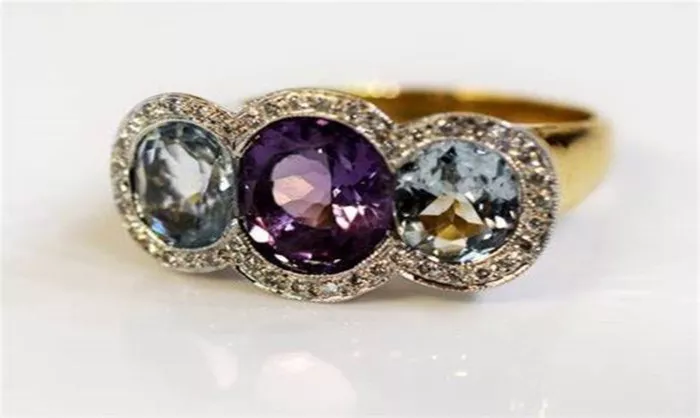Emerald amethyst necklaces, with their captivating blend of green and purple gemstones, hold significant cultural and traditional meanings in various societies around the world. Here’s an in – depth exploration of the cultural traditions associated with wearing such necklaces
Ancient Civilizations
Egypt: The ancient Egyptians held emeralds in high regard and associated them with the goddess Isis, who was often depicted wearing emerald – adorned jewelry. Emeralds were believed to have healing powers and were thought to ensure a peaceful afterlife. Amethysts, too, had a place in Egyptian culture. They were used in jewelry and were seen as a symbol of protection against drunkenness and excess, perhaps due to their color resembling that of red wine. While there isn’t specific evidence of emerald – amethyst necklaces in particular, the combination of these two gemstones in a necklace could potentially symbolize a balance between the healing and spiritual powers attributed to emeralds and the protective and tempering qualities of amethysts.
Greece and Rome: In ancient Greece and Rome, emeralds were associated with the goddess Venus and were believed to enhance love and fertility. Amethysts were considered a symbol of sobriety and were often used in religious ceremonies and as a talisman against evil. The Greeks and Romans were known for their elaborate jewelry designs, and it’s possible that emerald – amethyst necklaces were created. Such necklaces might have been worn by women to attract love and protect themselves from negative influences, combining the virtues of both gemstones.
Asian Cultures
India: In Indian culture, gemstones are deeply intertwined with astrology and Ayurveda. Emeralds are associated with the planet Mercury and are believed to enhance intelligence, communication, and business success. Amethysts are linked to the planet Saturn and are thought to bring peace, calmness, and spiritual growth. Emerald – amethyst necklaces could be seen as a harmonious combination that promotes both worldly success and inner peace. These necklaces are often worn as part of traditional bridal jewelry or on special occasions to attract good fortune and blessings. They are also considered a form of investment and a symbol of wealth and status.
China: In Chinese culture, jade, which comes in various green colors similar to emeralds, has long been highly prized for its beauty and symbolic meanings. Jade is associated with purity, virtue, and immortality. While emeralds are not native to China, they have been incorporated into Chinese jewelry in more recent times. Amethysts have also found their way into Chinese adornments. The combination of emerald – like green and amethyst purple in a necklace might be seen as a harmonious blend of colors, with green representing growth and vitality and purple symbolizing royalty and nobility. Such necklaces could be worn to express elegance and a connection to both earthly and spiritual realms.
Western Cultures
Medieval Europe: During the Middle Ages in Europe, gemstones were often associated with specific virtues and were used in religious and secular jewelry. Emeralds were seen as a symbol of faith and hope, while amethysts were considered a symbol of repentance and humility. Emerald – amethyst necklaces might have been worn by nobles and the clergy alike. For the nobility, these necklaces could represent a display of wealth and a connection to spiritual virtues. For the clergy, they might have served as a reminder of their religious duties and the need for humility and repentance.
Victorian Era: The Victorian era in England was known for its elaborate and sentimental jewelry. Emeralds and amethysts were both popular gemstones during this time. Emeralds were often given as a symbol of love and affection, while amethysts were associated with loyalty and constancy. An emerald – amethyst necklace from the Victorian era would likely have been a romantic gift, perhaps given to express deep and lasting love. The intricate designs and use of these gemstones in combination would have been a reflection of the era’s emphasis on beauty, sentiment, and craftsmanship.
Modern Cultural Significance
Spiritual and New Age Beliefs: In modern times, many people are drawn to the spiritual and metaphysical properties of gemstones. Emeralds are often believed to have a connection to the heart chakra, promoting love, compassion, and emotional healing. Amethysts are associated with the third eye chakra and are thought to enhance intuition, spiritual awareness, and meditation. Wearing an emerald – amethyst necklace is seen by some as a way to balance and align these chakras, promoting overall well – being and spiritual growth. This has led to the popularity of such necklaces in the New Age and holistic health communities.
Fashion and Self – Expression: Emerald – amethyst necklaces have also become a popular fashion statement. The combination of the rich green and purple colors makes a bold and eye – catching statement. People wear these necklaces to express their individual style, to add a pop of color to their outfits, or to make a fashion – forward statement. They can be worn with both casual and formal attire, depending on the design of the necklace. In this sense, the cultural tradition has evolved to include self – expression and the celebration of personal style.


